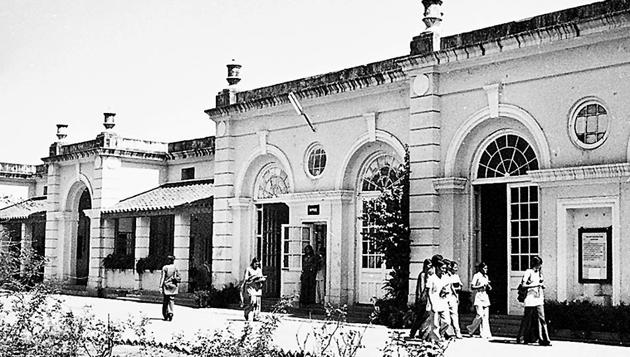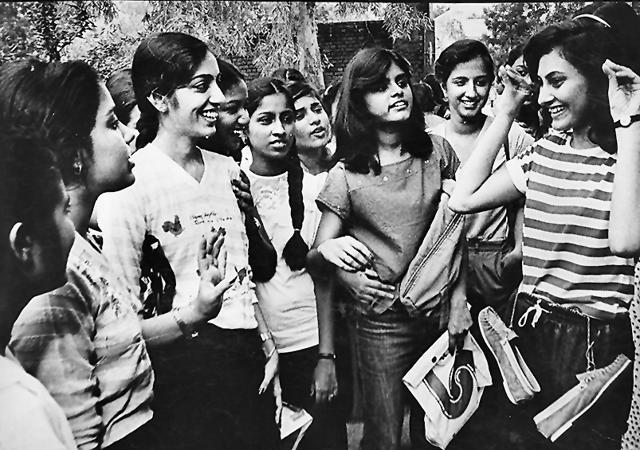DU’s women colleges: Finding their own freedom, fighting for Independence
From expanding the scope of academic learning to being the cradle of modern feminism, the women’s colleges of DU that first came up in the old quarters of the city, have played an important role in shaping education for women through the 20th century.
In 1973, when shy, introverted 17-year-old Manaswani Yogi graduated from school, she wanted to apply to just one college for admission — Indraprastha College for Women (IP College). Her elder sister was a lecturer there. However, that was not why she chose it, but because of its rich history and reputation as Delhi’s first women’s college that had produced young, spirited women leaders who played a significant role in the country’s freedom struggle.

“I was also impressed by its great academic discipline and the grandeur of its building,” said Yogi, now 64, who went to Queen Mary’s school and lived inside the Delhi University (DU) campus, where her father was a Hindi Professor in St Stephen’s College.
From expanding the scope of academic learning to being the cradle of modern feminism, the women’s colleges of DU that first came up in the old quarters of the city, have played an important role in shaping education for women through the 20th century.
In recent years, Delhi’s women’s colleges have regularly emerged as the highest ranked institutions in the country. Miranda House, for example, has maintained the top position for three consecutive years in the annual rankings put out by the National Institute Ranking Framework (NIRF). In fact, 10 others out of the 22 women’s colleges were ranked in the top 100 list for 2019. No wonder then, that there has been a scramble among students from across the country for admission to these colleges, which have announced some of the highest cut-offs in DU.
Back in the early decades of the 20th century, however, the options for education in an all-women environment were fairly limited. It was a time when most families were strictly against educating girls, particularly in the company of men. But Annie Besant, president of the Theosophical Society, believed in the necessity of the upliftment of women for the sake of the country’s development. “Of this we may be sure, that Indian greatness will not return until Indian womanhood obtains a larger, a freer and fuller life,” she wrote in a letter to the secretary of the local branch of the society, Lala Balkishan Dass in May 1904. It was in response to this letter that the Indraprastha Putri Pathshala , an all-girls school, was opened on May 20, 1904, in two rooms of a haveli in the vibrant neighbourhood of Chippiwara overlooking Jama Masjid. By 1924, it developed into the first women’s college of the city, when it was rechristened Indraprastha College for Women.
Post-Independence, Miranda House, was established in 1948 by the then vice-chancellor of Delhi University, Maurice Gwyer after he failed in his repeated attempts to shift IP to the DU campus. The college, which is known to have been preferred by women from the elite quarters of old Delhi, such as Civil Lines and Kashmere Gate, has had a reputation of producing free-thinking, bold women.
“Right from the beginning, I experienced this sense of freedom. You could do what you wanted to do, dress as you like. There was no moral, or institutional surveillance of any kind,” said retired professor of English, Svati Joshi, who started teaching at Miranda House as a 23-year old in 1973. With a glowing alumni list including names such as the first woman speaker of the Lok Sabha, Meira Kumar, former chief minister of Delhi, Sheila Dikshit, and filmmaker Mira Nair, Miranda House has consistently been ranked as one of the best colleges of the country.

Established in the 1930s, Lady Irwin College, too, played an important role in transforming the traditional academic curriculum. It was the first institute in the country to offer degrees in home science. “This was a revolutionary moment. Women were getting degrees for work done inside the kitchen, thereby earning a certain prestige,” says Sydney Ribeiro, advisor and dean of alumni affairs in DU.
The massive influx of refugees after Partition led to an increasing demand for colleges serving the educational needs of women. From the mid-1950s, a few philanthropic entrepreneurs opened colleges across the city.
Lady Shri Ram College (LSR) was established by the Delhi Cloth and General Mills founder, Lala Shri Ram, in 1956 in honour of his wife Phoolan Devi. From its humble origins in a school building at Daryaganj, the college moved to Lajpat Nagar in 1958. Within a few years of its establishment, it had caught up with Miranda House and St Stephen’s College as one of the foremost colleges of the university, and was particularly pitted against the former --both in terms of academic performance and setting new trends. The college boasts of a strong alumni including, Nobel laureate and leader of Myanmar, Aung San Suu Kyi, and chief economist of the International Monetary Fund Gita Gopinath. During its initial years, LSR was favoured mostly by upper-class, orthodox families in the upcoming southern parts of the city.
Asha Mathur, 74, who joined LSR in 1960, recalls that the reason she chose the college was because it was a short distance from the Sarojini Nagar government quarters where she lived, and also because a family friend’s daughter was already studying there. She remembers that they had a fairly set routine during the college days. She travelled by the ‘LSR special’ buses, which were considered safe; began college with a prayer assembly; and spent the day mostly doing academic activities. “I never went out of college. Where would one go? There were just villages and forested land around the college back then. Some girls used to hang out at a little temple on a hill near the Zamrudpur village. I did not know them, but they were considered too bold,” she said.
The beloved ‘cafe’ that the college boasts of today was merely a canteen selling tea and snacks such as bhel puri. In the absence of a college festival, an annual fete took place in the college for students and teachers who put on display goods such as hand-made cushion covers and handkerchiefs.
Businessman and educationist Daulat Ram Gupta established Pramila College in 1960, named after the wife of the then vice-chancellor, renowned economist VKR Varadaraja Rao. The institution, which was built specifically to meet the educational needs of women from lower income groups, later changed its name to Daulat Ram.
In the 1960s, the Delhi government built several colleges for women, such as Kamala Nehru, Gargi, Maitreyi, Shyama Prasad Mukherji and Bharati, to expand the avenues for women’s education in the city, particularly in the rural extensions of the southern and western parts, which were being urbanised to meet the demands of a rising population. A large majority of them came up in abandoned rooms of government school buildings, with hardly any infrastructure or facilities to begin with.
Kamala Nehru and Gargi colleges, for instance, were first housed in two schools at Defence Colony. While the former was named Modern College for Women, the latter was called The Government College for Women. Both these colleges, presently among the most sought-after in the university, stand beside each other today on Siri Fort Road. Sharing a similar historical trajectory has resulted in the two colleges being arch-rivals. “I remember when we used to have inter-college competitions, it was mandatory to ensure that Gargi loses. It did not matter if any other college won,” recalls Archana Ojha, 56, who was a student at Kamala Nehru College in the 1980s.
Life inside the campus, which had become a hub of many colleges, was very different. The students of the women’s colleges on the campus have many memories of friendships and rivalries. Kalpana Bhakuni (57) who joined Miranda House in 1979 as a geography student, recalls how conscious Miranda women were of the exclusive tag of their college. Despite living in the south Delhi neighbourhood of Malviya Nagar, she chose the college because of its presence inside the campus and all the excitement that came with it. Equally exclusive, she recalls, was the special relationship that the institute shared with St Stephen’s.
“We used to host socials every few days, and only boys from St Stephen’s were allowed. Boys from Hindu College used to be very upset about this,” she said with a laugh. Bhakuni went to school near Dehradun, where her father worked in the biggest antibiotic factory of the country. IP College, on the other hand, had a similar affinity towards Hansraj College. “Hansraj was a DAV college. The atmosphere there was similar to that in our college. These were simple people, like us,” said Yogi.
It is also interesting the way the women’s colleges, both inside and outside the campus, were dealing with women’s issues. “We frequently had counselling sessions with the girls. We often had complaints from girls of their parents wanting to marry them off, or there being a financial crunch to pay fees,” said Bimla Dhar, 81, who was a professor of English at Gargi from the early 1970s to 2002. “We would often reach out to parents to help the girls or assist in getting fees concessions for them,” she added.
“By the late 1970s, the women’s movement peaked. Discussions around gender and women had begun. One was very often on the streets, digging out facts about incidents of violence against women,” said Joshi about Miranda House’s involvement with feminist and humanist movements inside the DU campus.
The women’s colleges that were outside the campus, however, have not been as strongly linked with university students’-led agitations. Defending Kamala Nehru College’s lack of involvement in university student politics, Ojha believes that even then the students were extremely politically active inside the college. “I remember in the 1980s, there was an unpleasant incident with some foreigner students, and we went on strike. But our activism was restricted to the boundaries of our college,” she said.
Talking of the relevance of the women-only colleges today, many students feel that a women’s college continues to offer an unmatched sense of freedom and opportunities. “These include an opportunity to self explore, self express and self assert,” said Geetesh Nirban, professor of philosophy at Kamala Nehru. “St Stephen’s got its first female president a couple of years back,” said Yogi. “I know a girl who comes to college wearing a loose shirt over tight-fitting clothes. The moment she steps in, she immediately takes off that shirt, bundles it up and shoves it inside her bag. It is her moment of freedom,”said Bhakuni, the principal of Kamala Nehru College.
Get latest news on Education, Bihar Board 12th Result 2024 Live along with Board Exam, Competitive Exam and Exam Result at Hindustan Times. Also get latest Job updates on Employment News









